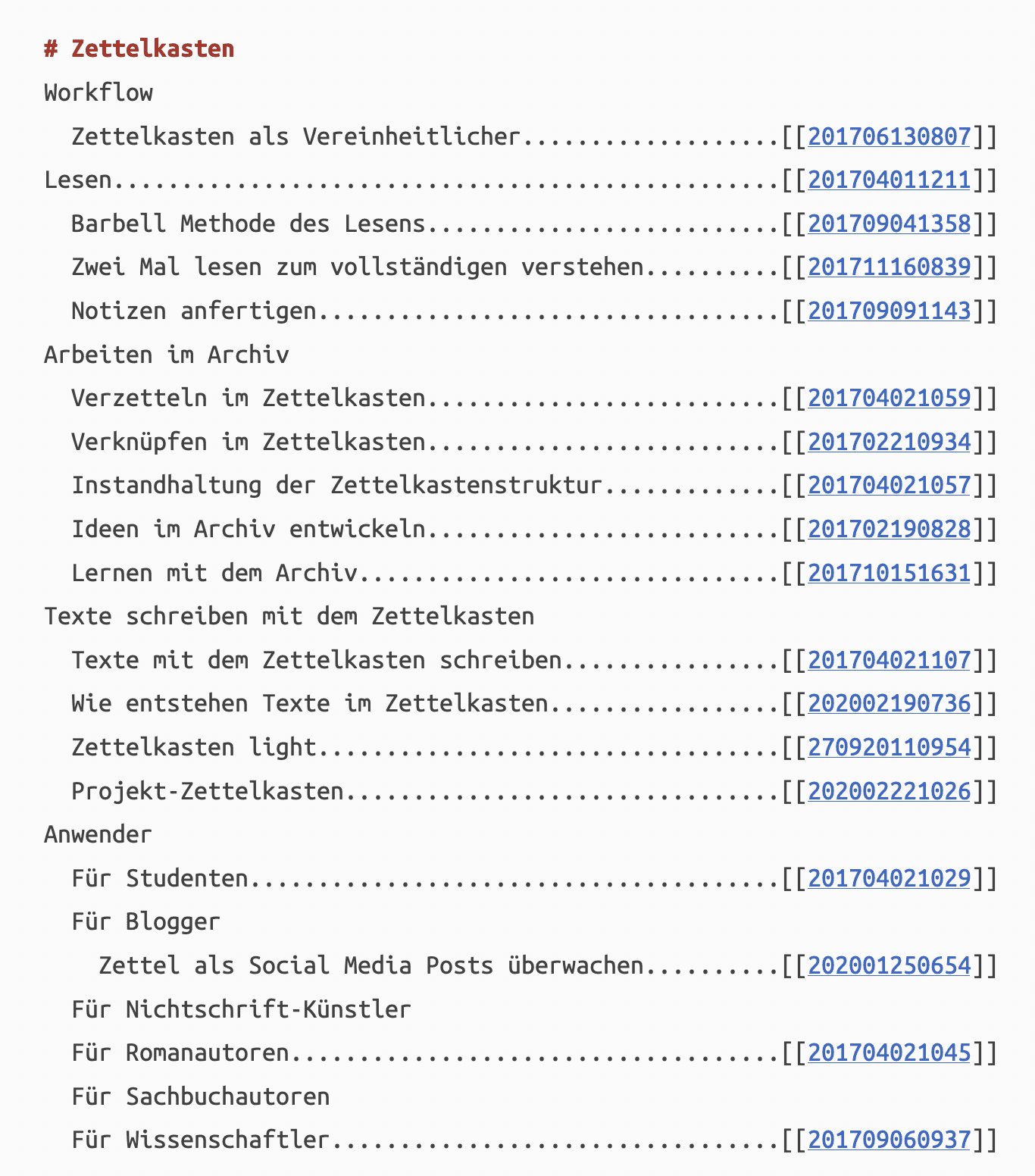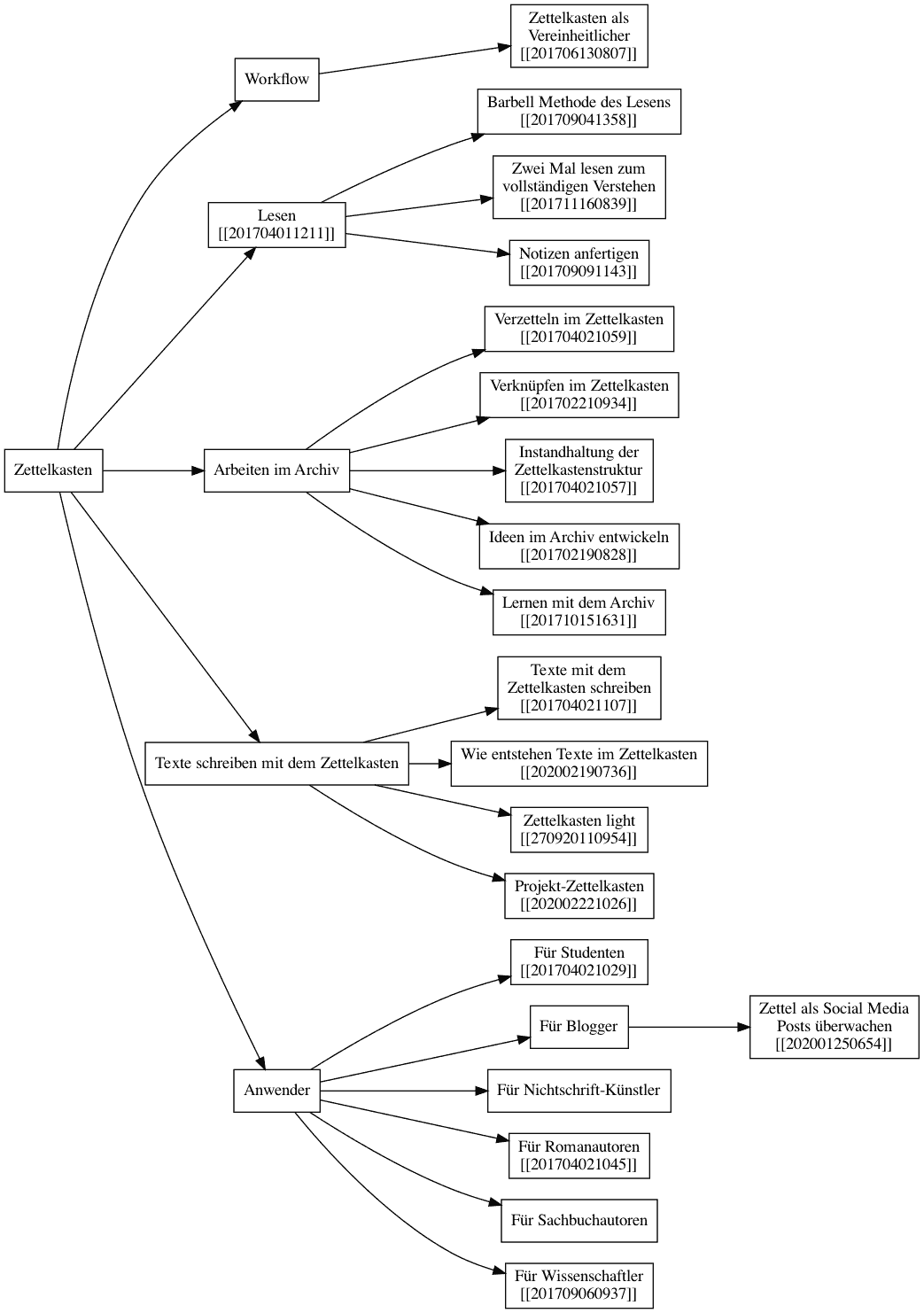Introduction to the Zettelkasten Method
Why are you reading this introduction? The chances are that you either have an immediate need to solve the riddle of knowledge work, feel overwhelmed by your master’s thesis, try to level up your blog, want to write a book because it’s cool, try to get on top as a consultant, excel at research, or something like that. But the Zettelkasten Method is more than just a tool to finish some work or project. It is a holistic method on how to deal with knowledge in your life.
The Zettelkasten Method is an amplifier of your endeavors in the realm of knowledge work. It is highly effective, and many people report they have more fun, one even comparing it to the addictive nature of games like World of Warcraft, and have an easier time doing knowledge work overall. But this only comes as a result of putting in a high level of consistent effort.
It is like swimming. If you can’t swim, you won’t be having any fun at all. Swimming sucks if all you do is float (or even sink) and fight the water. But boy, if you figure out the technique and glide through the water, it is incredible. But you don’t learn swimming by aiming for ease and fun. You learn to swim by aiming to be fast and graceful.
The Zettelkasten Method needs some practice. First, you will have the feeling that you don’t do anything useful. But with a little bit of practice and patience, you will surprise yourself and produce gems of knowledge.
This introduction is meant to guide your first steps towards excellence. Follow this path and your Zettelkasten will provide you with the tools to thrive on intellectual adventures.
If I had to explain to someone unfamiliar with the concept of Zettelkasten, I’d describe it like this:
A Zettelkasten is a personal tool for thinking and writing. It has hypertextual features to make a web of thoughts possible. The difference to other systems is that you create a web of thoughts instead of notes of arbitrary size and form, and emphasize connection, not a collection.
The Zettelkasten, as we know it today, really took off with Niklas Luhmann, the godfather of the Zettelkasten Method, the most powerful tool for thinking and note taking out there.
Luhmann’s Zettelkasten
Niklas Luhmann was a highly productive social scientist. He published 50 books and over 600 articles.1 He didn’t achieve this on his own. He had quite a companion.
There are also over 150 unfinished manuscripts left in his estate. At least one of them is a text of 1000 pages. So his productivity surpassed even his already astonishing body of published work.
Luhmann himself stated that his productivity stems from working in a partnership with his Zettelkasten. This strikes a chord with people investigating the Zettelkasten Method.2
Luhmann’s Zettelkasten is a collection of notes on paper slips with a special twist: It is a hypertext that he could navigate the drawer cabinet containing all the paper slips with a reasonable amount of time and energy. “Reasonable” means that it was reasonable for Luhmann, who, obsessed with his theory of society, was a workaholic and an enthusiastic bureaucrat. A hypertext needs to be surfable. On Wikipedia, you just need to click a link to get to the next article within Wikipedia’s hypertext. It requires more effort to follow a link if the hypertext is paper-based. The other problem is that you need a starting point for your ride. So Luhmann created his Zettelkasten to make his note collection surfable. He needed entry points and a mechanism to surf from one note to another in a productive way.
We are lucky because we have access to powerful digital tools. Handling a physical Zettelkasten is way more difficult and labor intensive than a digital one. We don’t have to be bureaucratic workaholics to reap the benefits of the Zettelkasten Method.
Why Are We So Interested In Luhmann’s Zettelkasten?
First, we fantasize about what it would mean to be as productive as Luhmann. Luhmann’s Zettelkasten seems to inspire people, which is one of the main drivers why interest in his method of production is surging.
Second, Luhmann’s Zettelkasten promises to be quite an improvement to run-of-the-mill approaches to note-taking and knowledge work in general. It amplifies your effectiveness. It is possible to produce more in less time, but not with less effort per time. If we accept this we can improve ordinary note-taking methods in several ways:
-
We can improve the connectivity of our thoughts. The hyper-textual nature of the Zettelkasten enables us to connect ideas. These connections make new insights possible. Insights don’t happen in a vacuum. They are the result of making new (unexpected) connections.
-
We can be more productive. The Zettelkasten Method streamlines our workflow by giving clear guidelines on what to do. This, in turn, decreases friction. It is quite common to enter a stage of flow which further increases productivity. I even allocate two days per week to make Zettelkasten work my priority and allow Zettelkasten flow to happen.
-
We stop wasting our efforts. Even if you don’t use any of your notes for a project you’re working on at the moment, you prepare the knowledge for future projects. At the very least, you improve the depth of processing information from that topic.
-
We can tackle more complex problems. It is very difficult to keep all the balls in the air if you juggle complex problems. The Zettelkasten Method allows you to concentrate on a small part of the problem and after that take a step back and look at it with a panorama vision.
-
Normal note-taking will create a bloated mess over time. The Zettelkasten on the other hand will scale itself automatically to the size of the problem you are tackling. This is what Luhmann talked about when he wrote about “internal growth” (I translated it into “organic growth”) in his manual.
-
The Zettelkasten Method will make your writing easier, more coherent, smoother and more convincing. One of the main problems in writing and thinking is our limited capacity to follow one line of thought for a long period of time. Just think of meditation. It is even difficult to focus on a simple thing like breathing for a couple of minutes. Imagine how difficult it is to think about one issue for weeks and months to write a thesis. The Zettelkasten will hold your thoughts alive and help you to hold onto them.
We have to make notes to wrestle with problems effectively. To put it in Luhmann’s words:
What are we to do with what we have written down? Certainly, at first, we will produce mostly garbage. But we have been educated to expect something useful from our activities and soon lose confidence if nothing useful seems to result. We should, therefore, reflect on whether and how we arrange our notes so that they are available for later access.
The result of Luhmann’s own note-taking effort was his Zettelkasten. Let’s dive in and see how he achieved this to extract some general principles.
The Fixed Address of Each Note
If you want to refer to an individual note, it needs to have a fixed and unique address by which you can identify the note. It is necessary to make the actual lookup possible. In our digital age, we rarely think of this problem unless we are software developers. We are used to performing a search on the web, and in a fraction of a second, our search presents us with the results. When you deal with a bunch of paper notes, however, you need to make it possible and bearable to get anywhere at all. Luhmann’s approach was a clever numbering system.
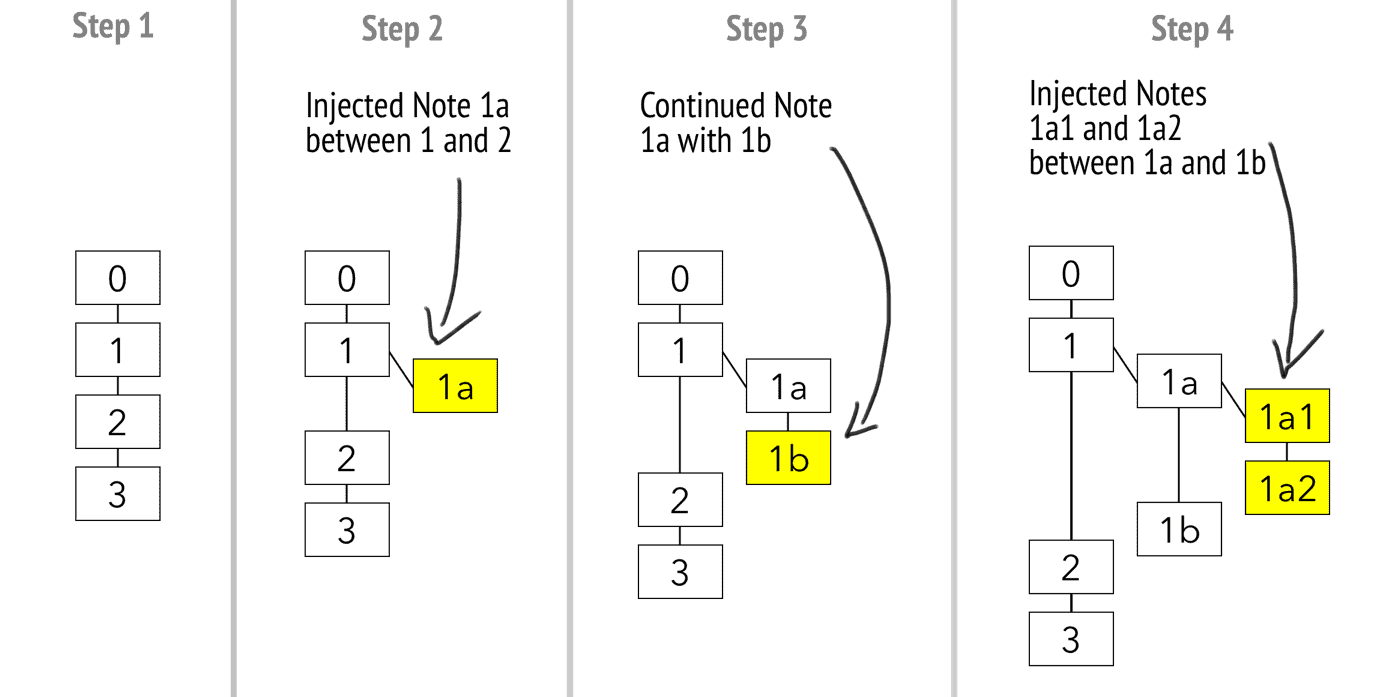
The very first note is assigned the number 1. If you add a second note that is not related to the first note, it is assigned the number 2. But if you want to continue the first note, or inject something into its content, comment on it, or something along those lines, you branch off. That new note would get assigned the number 1a. If you continue with this new note, you would go on with 1b. If you then want to comment on the note 1a, you would create a note with the address 1a1. So, in short, whenever you continue a train of thought, you increment the last position in the address, be it number or a character from the alphabet. And when you want to expand, intersperse, or comment on a note, you take its address and append a new character. For this to work, you alternate numbers and characters.3
Luhmann’s numbering system has two consequences for re-creating his method:
-
It makes organic growth possible. Luhmann didn’t use the term hypertext, but he probably would if he lived today. This organic growth is also precisely how wikis and their wiki-link feature works. You have a text but want to expand on a point. You branch off from the current page, and thus basically inject another text into the current one, but at the same time hide its contents.
-
It makes linking possible. The emphasis on linking is a more obvious hint at the hyper-textual nature of his Zettelkasten. The non-linear link structure is the main trait of a hypertext. In his manual on how to create a Zettelkasten, he wrote: It is not important where you place a new note as long as you can link to it.
His numbering system made a paper-based hypertext possible. It worked with a bearable amount of effort for Luhmann.
At this stage, we have a surfable hypertext. But we do not have something like a search engine to enter the hypertext. “Where to start?” is a question Luhmann needed to answer. He used his register as the place to start, his entry point.
Luhmann’s register could be mistaken for a tag system. However, the individual notes were not tagged, nor did he put a tagging system in place to organise his Zettelkasten.
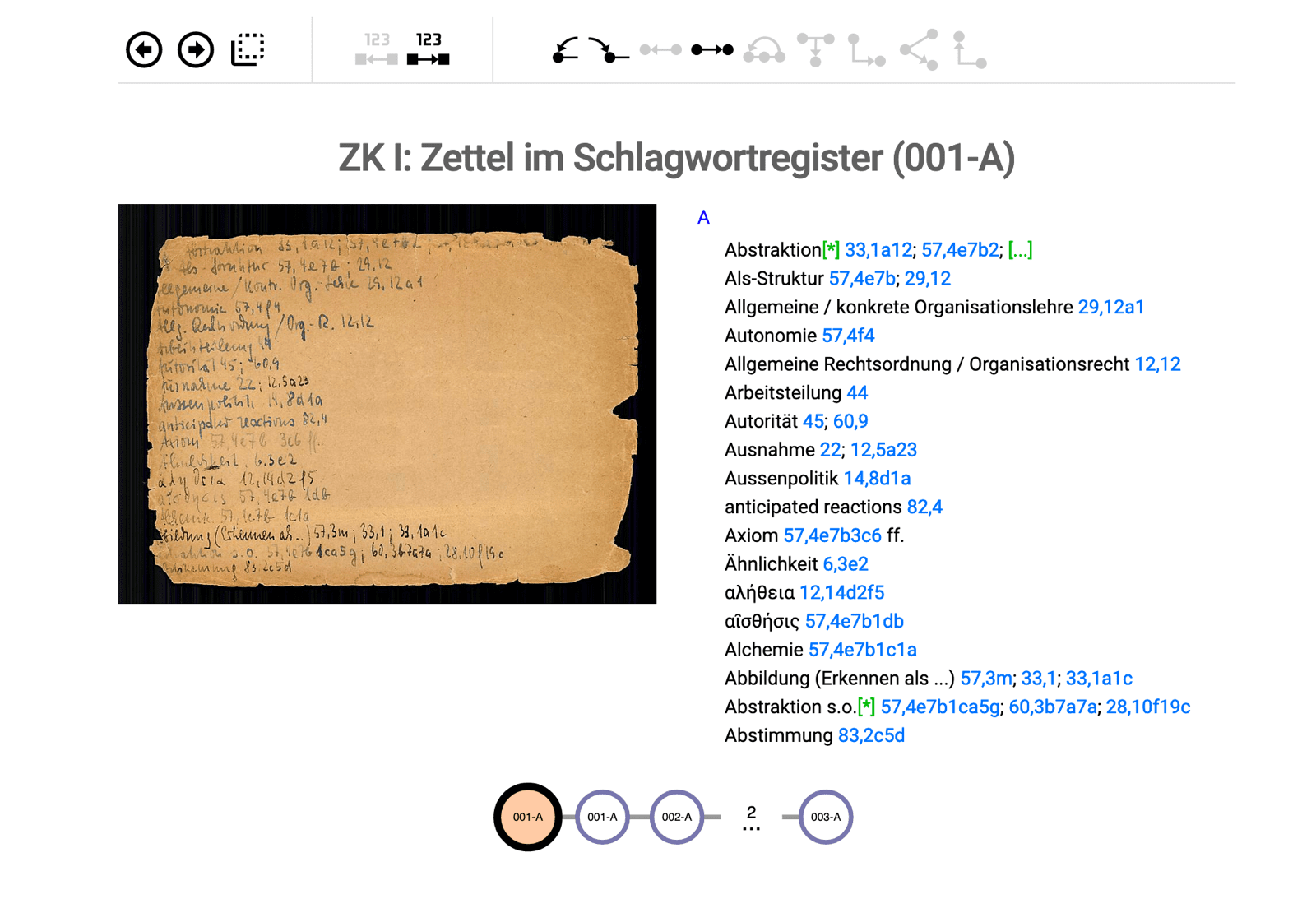
There are very few IDs per item in his register, sometimes just a single one, next to each term. His register is purely a list of entry points, not a tag list. For example, the term system had just one entry. This is a huge surprise when you consider that Luhmann was developing a systems theory where this term played a huge role all over the place. The register was only a list of possible entry points to the biggest and most important clusters of notes. After finding the entry to his hypertext, he relied on the linking system and began to surf.
The fixed address of each note is the alpha and omega of the world of Zettelkasten. Everything becomes possible because of it.
If you want to replicate the functionality of Luhmann’s Zettelkasten, you would have to create a hypertext and limit your entry into it via the most central pages on a topic, from which you would continue by following links.
A Zettelkasten Is a Personal Tool for Thinking and Writing
In contrast to other approaches, Luhmann decided against making his Zettelkasten stiff and opted for an organic approach instead. There’s a reason his own manual is titled “Communicating with Slip Boxes”, and not something like “A slip box as a writing and thinking tool”. Our point of reference is that The Zettelkasten Method is an organic and non-linear, even living, approach on note-taking.
Let us begin with the most important traits of a Zettelkasten:
- It’s hyper-textual.
- It adheres to the Principle of Atomicity.
- It is personal.
First, it is some kind of hypertext, not a single text or just a collection of texts, but texts that refer to each other, explain, expand and use each other’s information. The difference between regular note-taking systems and a Zettelkasten is the emphasis on forming relationships. A Zettelkasten makes connecting and not collecting a priority. The difference between just a text and hypertext is that the former is linear and the latter is organic.
To become a hypertext, a Zettelkasten requires multiple texts, or notes, that you can connect via hyperlinks. We call an individual note a Zettel. Zettel is the German word for “paper slip”. They are the smallest building blocks of the Zettelkasten.
Each Zettel needs a unique address by which we can refer to it, to make connections between Zettels. Then there can be hypertext and the note-taking system can qualify as a Zettelkasten.
Second, the principle of atomicity is one of the core tenets of the Zettelkasten Method. Atomicity refers to the idea that knowledge is made up of discrete building blocks. The Principle of Atomicity is a processing direction in note-taking, aiming for one knowledge building block per note. It is not a rigid law, but a guiding compass. It needs to be contextualised for each application.
Let’s contrast this idea with non-atomic containers for knowledge:
Books, for example, have addresses and cross-references. They have chapters, sections, and pages. All have unique numbers that can be referenced. However, you cannot refer to a thought, an idea, or any content. Chapters, sections, and pages are more like coordinates. A thought might span the entire book! You cannot refer to it directly with just one reference.
A book is not a web of thoughts. Likewise, Wikipedia is not a web of thoughts because you can only link to articles and sections within them, but not to individual thoughts inside the text. None of the addresses corresponds to any thought. Wikipedia is not intended to be such a thing. Instead, Wikipedia is an encyclopedia that contains articles on various topics. Wikipedia is not a thinking tool but a tool for information retrieval.
Third, there is one Zettelkasten per person, and one person per Zettelkasten. Thinking is a different process from communicating with another person. You want your Zettelkasten to be a personal thinking tool. If you don’t keep your diary absolutely private, you wouldn’t write some things down, and you’d filter other things, therefore distorting them. Writing for yourself is and should be different from writing for the public.
That does not mean that it is never useful to create a shared, project-specific hypertext. But that is not what we are talking about when we talk about a Zettelkasten.
That brings us back to our short definition:
A Zettelkasten is a personal tool for thinking and writing. It has hypertextual features to make a web of thoughts possible. The difference to other systems is that you create a web of thoughts instead of notes of arbitrary size and form, and emphasize connection, not a collection.
With that, we have a working definition. How do you Zettelkasten-ify your thinking and writing?
The Anatomy of a Zettel

What does an individual note, a Zettel, look like? There are three components that each Zettel has:
-
A unique identifier. This gives your Zettel an unambiguous address.
-
The body of the Zettel. This is where you write down what you want to capture: The piece of knowledge.
-
References. At the bottom of each Zettel, you either reference the source of the knowledge you capture or leave it blank if you capture your own thoughts.
It is really that simple. If you are doubting if you are doing it right always come back to the simplicity of these basics. All you need to enable the hypertext, the bare minimum, is an address, that is the unique identifier, and of course some content in the note.
The Unique Identifier
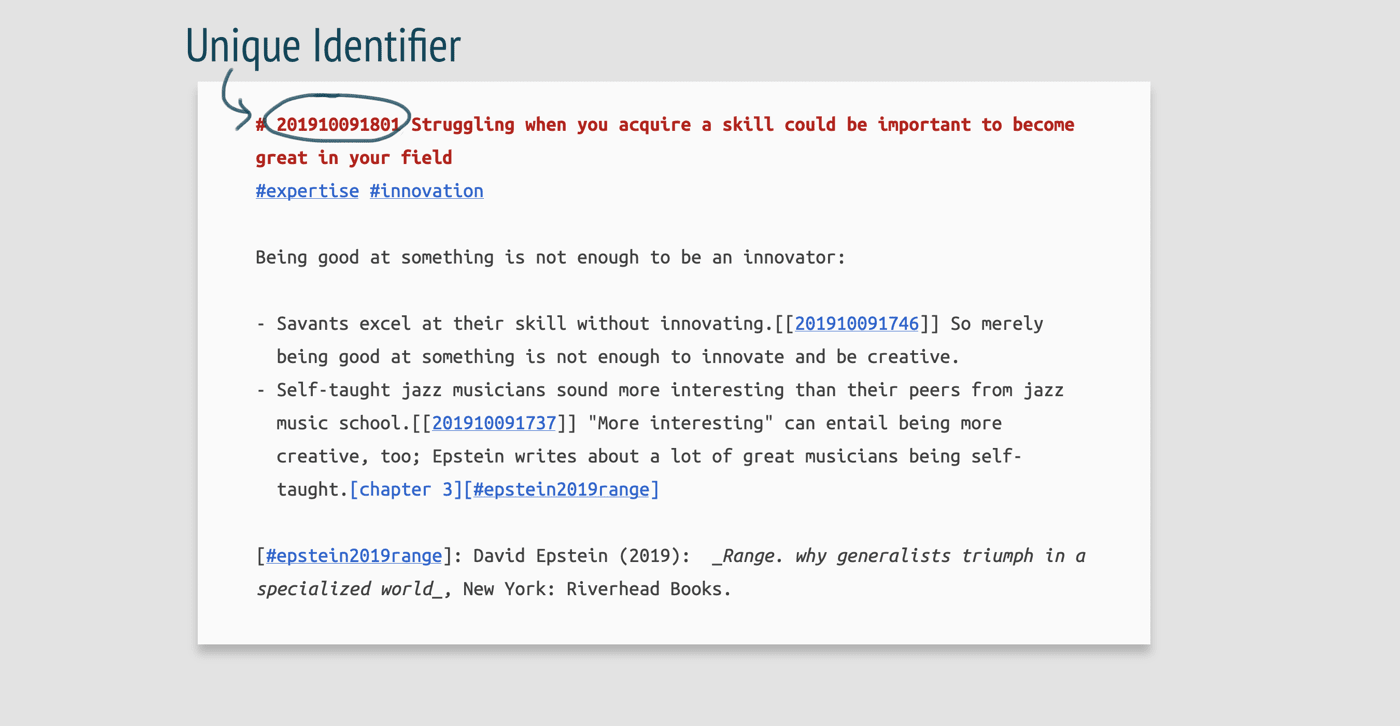
The unique identifier (ID) is mandatory to create a Zettelkasten. Only with a unique identifier you can address Zettel individually. Only with that capability, you can create a web of thoughts that will assist you with your endeavors in knowledge work.
There are several ways to identify notes, the most common are:
-
There is of course the Luhmann-ID. You create some kind of arbitrary hierarchy wherein each Zettel has a place where it could be. Using a paper-based Zettelkasten, I recommend using this technique because it helps to deal with its organisation. The other types of ID wouldn’t work as well for paper.
-
You could chose a Time-based ID. With a digital Zettelkasten, unlike with a paper-based one, there is no real place for a note. To create the hypertext, you need an address, but not a place. A time-stamp is a very simple way to create a unique string of numbers to which you can refer. A sample time-based ID would be:
202006110955. Year 2020, 11th of June, 9 am and 55 minutes. -
You can use any arbitrary unique string. You could just use an incremental number, execute a program that generates a random but unique string, or whatever else you want. The main reason for me to consider this over time-based IDs is the promise to shorten IDs. For example, if you encode the date and time as a hexadecimal number,
202005191402could be shortened to2F08729AEA. This is a direct translation of the timestamp. That would shorten the string by two digits. There are more ways to make it even shorter than that. But you’d sacrifice some simplicity, and you wouldn’t be able to produce an ID manually. Also, this sacrifices human readability of the time of Zettel creation. Therefore, we do not recommend that approach. -
You could also use the title of the Zettel as its ID. As long as it is unique, it can serve as an ID. Consequently, you cannot change the title unless you change any reference to it if you want to keep your links intact. There is some software that would handle this problem for you, but we do not recommend this. We prefer a software-independent approach and keep our independence from software.
The Body of the Zettel
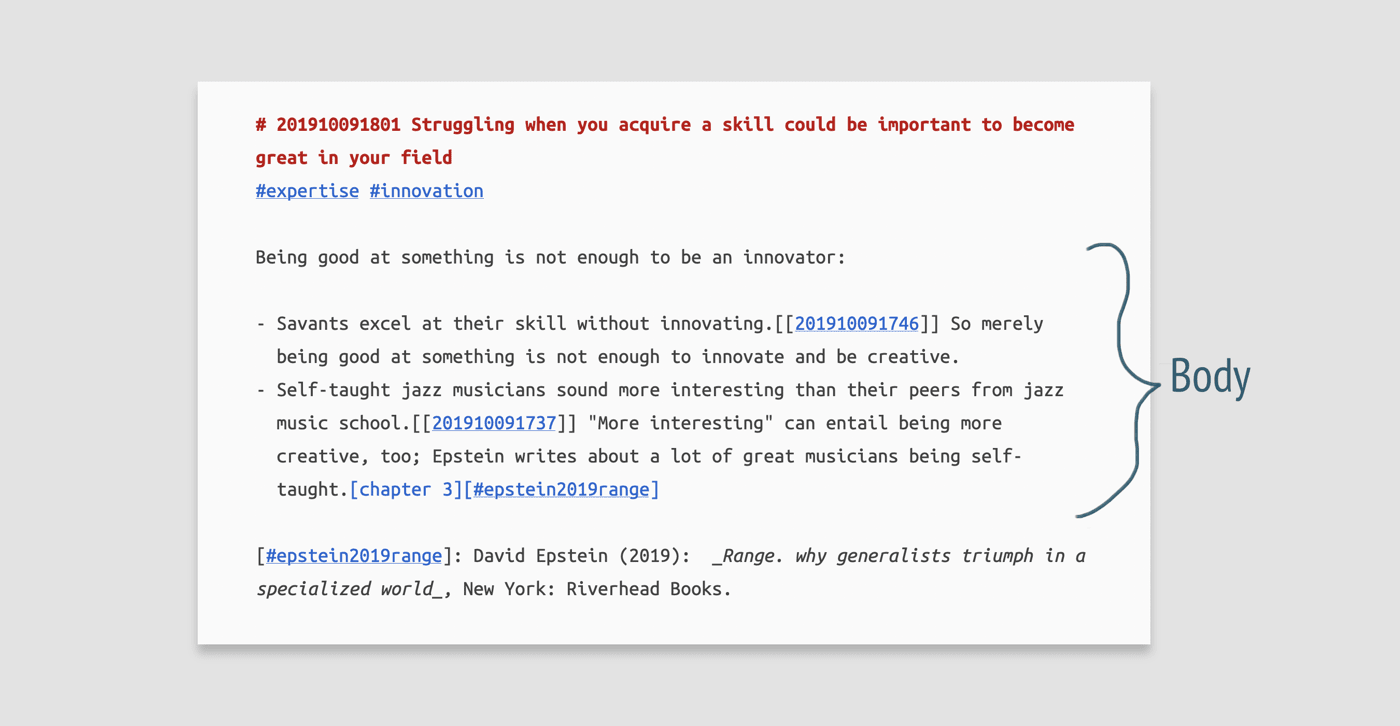
The body of the Zettel contains the piece of knowledge you want to capture. It could be an argument, a concept, or anything along those lines.
The most important aspect of the body of the Zettel is that you write it in your own words. There is nothing wrong with capturing a verbatim quote on top. But one of the core rules to make the Zettelkasten work for you is to use your own words, instead of just copying and pasting something you believe is useful or insightful. This forces you to at least create a different version of it, your own version. This is one of the steps that lead to increased understanding of the material, and it improves recall of the information you process. Your Zettelkasten will truly be your own if its content is yours and not just a bunch of thoughts of other people.
The length of a Zettel is directly tied to what kind of hypertext you want to create. Do you want to create a web of excerpts? Then a Zettel should contain precisely one excerpt. Do you want to make a web of thoughts? Then a Zettel should contain precisely one thought. A Zettel is the base entity that has its own address. Therefore the length of the Zettel, what you consider the atom you want to create molecules from, is determined by the objective you want to achieve. Your thinking operates in units of thought. A Zettelkasten can capture your thoughts and their relations as you design it that way. Therefore, we recommend limiting each Zettel to one thought each. Then your Zettelkasten will assist you in thinking instead of just assisting in creating excerpts.
In the Zettelkasten forum, @Nick asked how selective I am and what the nature of the information I put in is. Well, that depends on what you are thinking about. I recommend that you stick to knowledge instead of information.
The difference between knowledge and information, in practice, is quite simple. Information could be summarized in one sentence most of the time. Most of the time, it is “dead”. Information just is.
An example of a piece of information could be:
At this time (2020-05-20 09:14), I, Sascha, create the first draft of an article which has the working title “Zettelkasten – An introduction”.
What do you do with this? As a historian of the Zettelkasten Method, you could process it for a timeline of introductory articles on the Zettelkasten Method, to track the topic as it unfolds on the internet. Then you would create an empirical base of information for your historical work. But as a mere statement, it is quite useless. To most of us, it is just dead information and not knowledge.
As a rule of thumb, you should always make something from the information you process. You should always translate information to knowledge by adding context and relevance. Even if you don’t use the created knowledge directly, as long as you enrich the information with relevance you are on the right path. You don’t need to worry about what Zettelkasten forum user @grayen wondered in the context of taking notes from articles on the internet:
I sometimes struggle to determine whether it is worth writing a detailed Zettel about what makes the website worthwhile to write a Zettel about, but I don’t want to write for the sake of writing, and most of the time I am not sure if it is just transient stuff or whether it really is useful to keep around long term and not just for the processing of a particular thought/query I had. I don’t want to turn my Zettelkasten into busywork, i.e. a kind of procrastination. (slightly edited)
If in doubt, write the note, within the confines of your deadline. If you knew whether or not every piece of knowledge would be relevant to your final product, there would be no reason to take notes, because you would already have the final product in your mind. Every bit of knowledge you add has the potential to be useful in ways you might not be able to see in the moment you produce it.
In practice, you need to compromise between taking broad notes and focussing on your current projects. You cannot just take random notes on what you are interested in and expect to get anything done. So, use your current projects as golden threads to guide your work while allowing a bit of deviation from this path. The amount of deviation depends on what your deadline is.
The benefit of this habit is that you can maintain a flow of writing much more. I cannot count the many good ideas and texts I wrote while technically working on another project. By keeping the flow going you will produce more useful thoughts and text in the long run. The limits of this practice are the how much you need to achieve in the short-term.
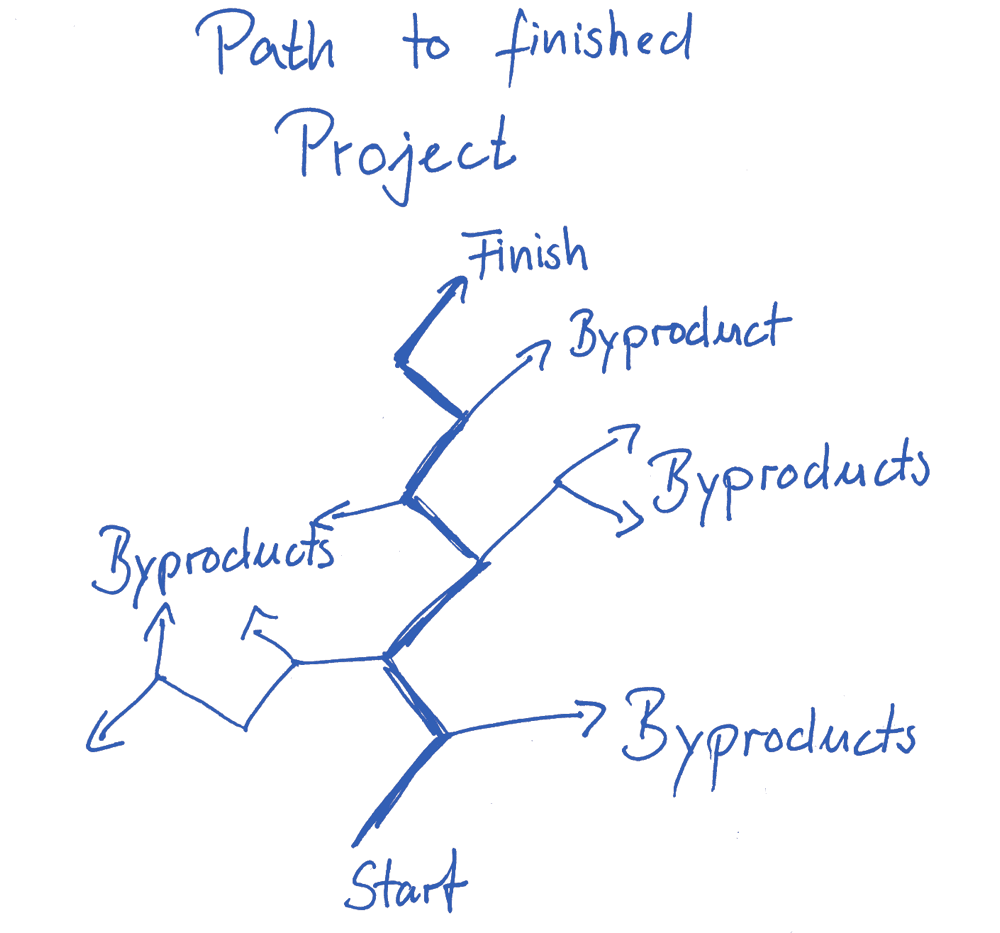
Those byproducts are not waste. In the long run, they become valuable knowledge for your future projects. Also, they form connections to other parts of your Zettelkasten and will enrich your personal learning experience while working with the Zettelkasten.
Example: I have a long-term book project. It is a very comprehensive book on nutrition which is part of a series on living a healthy life. One chapter was dedicated to the integration of nutrition into the other areas of responsibilities: Stress, training, everyday life organisation etc. I let myself loose and the result is that I wrote a whole book from this chapter.
Other Examples
-
If you are working on your bachelor’s thesis and are pressed for time, allow very little deviation and do focus on the source material relevant to your thesis.
-
If you are a retired mechanical engineer who spends your well earned free Sundays in a forest barn with your Zettelkasten to work on a novel, allow as much deviation from the project as you wish. Enjoy your time!
-
If you are a nurse who wants to publish a small book on how to deal with the healthcare system, don’t stress so much to get focused work done. You are doing so much for all of us already, you should enjoy the writing process and satisfy your intellectual curiosity, even if this slows down your progress.
-
If you are an ambitious type-A personality, allow room for deviation as much as you can endure. Your personality will ensure that you come back quite fast to the source material that is relevant for your project anyway.
Whether you should work focussed or allow deviation isn’t much of an issue of the Zettelkasten Method but more an issue of circumstances in your general life.
Reference
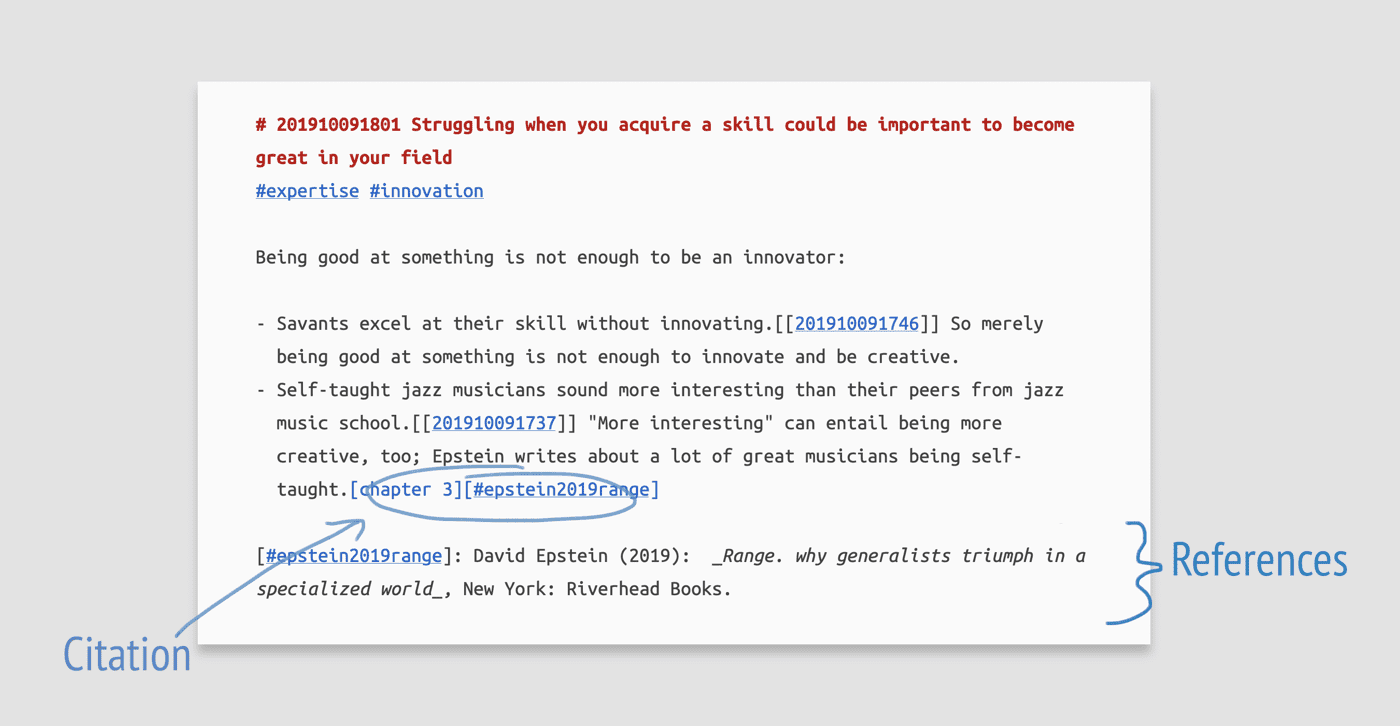
The reference part at the bottom of your Zettel states the sources of the information. The footer is the right place for external sources like books or articles from the web.
To manage the references, use reference management software like BibDesk. It will contain the bibliographical data and provides you with citekeys. Citekeys are similar to IDs. They are identifiers by which you can point to the reference you are using (One common format for a citekey is [#lastnameYEAR]).
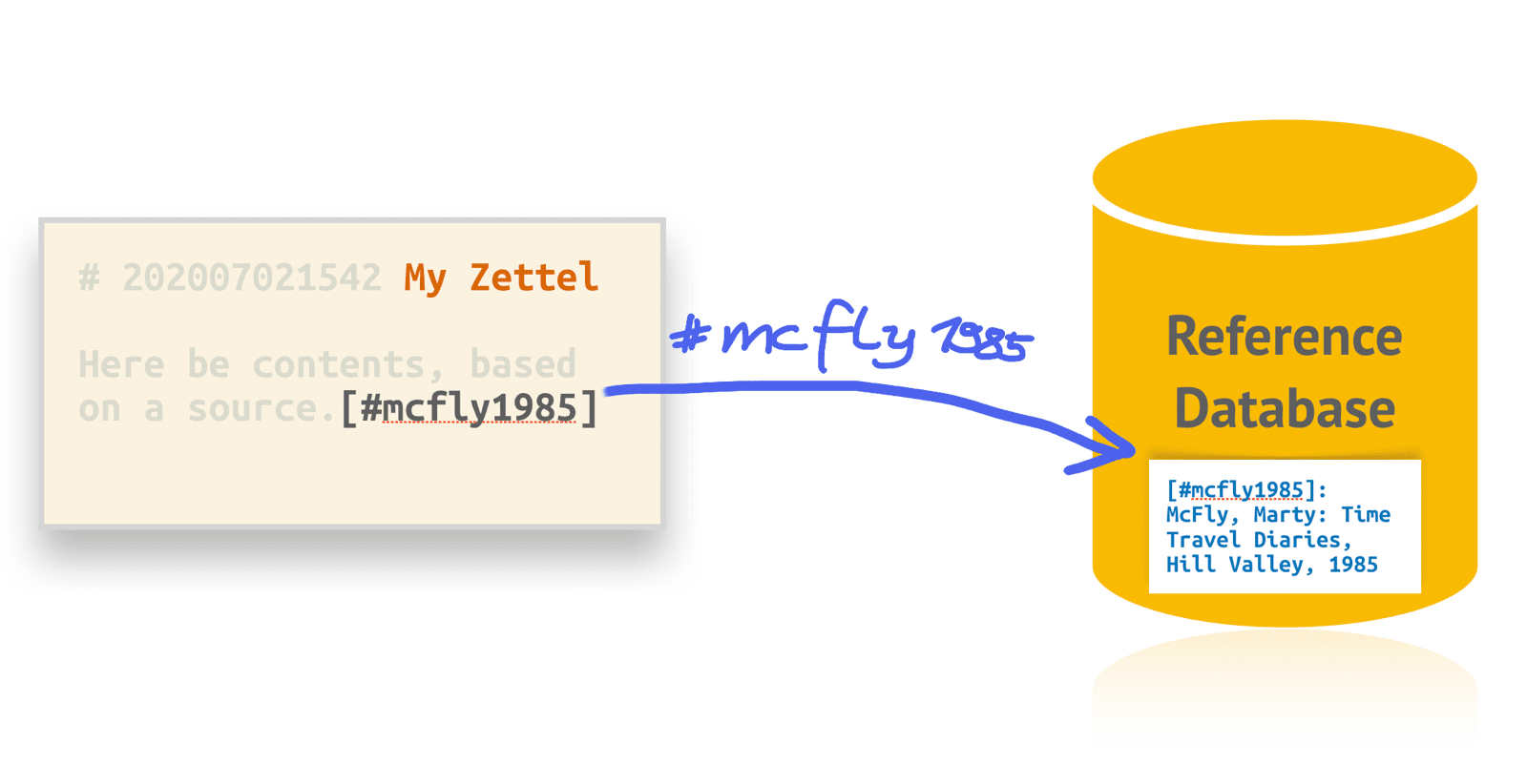
Sometimes, however, you will refer to other Zettel as your source of inspiration. In that case, you base your thoughts on something you have already processed in the past. You reference the Zettel by linking to it via the ID, connecting the new to the old.
If you have no reference at all, perhaps that means you wandered through the forest and had a sudden insight about the true nature of the world. In that case, you don’t need to do anything in this reference section. If no reference is given in a Zettel, it is your own thought by default.
Putting the pieces together
See this picture with all the elements pointed out.
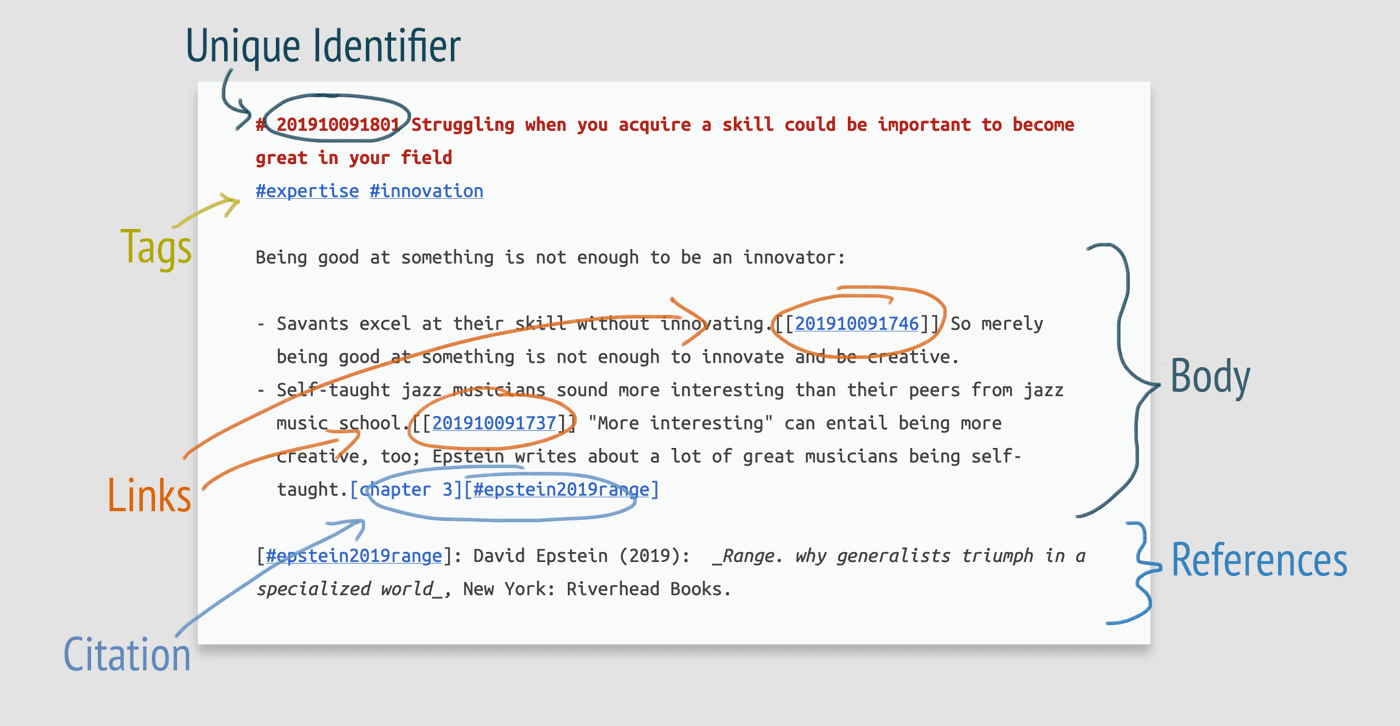
Up to this point, we have only looked at the individual Zettel. Now, let’s take a look at the relationship between Zettels.
Connecting Zettel
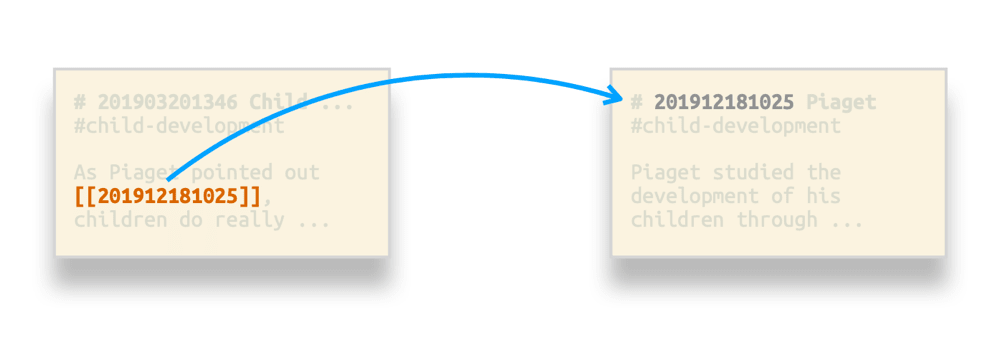
The true magic of a Zettelkasten, when compared to ordinary note-taking systems, comes from the heavy emphasis on connection. Each new Zettel needs to be placed in some relationship to another Zettel. Luhmann further stressed the importance of connecting every new Zettel:
If there are several possibilities, we can solve the problem as we wish and just record the connection by a link [or reference]. Often the context in which we are working suggests a multiplicity of links to other notes. […] In such cases it is important to capture the connections radially […], as it were, but at the same time also by right away recording [backlinks] in the slips that are being linked to. In this working procedure, the content that we take note of is usually also enriched. (from “Communicating with Slip Boxes”, emphasis mine)
The main benefit from connections is their effect on you and your brain: When you relate pieces of knowledge to others, you create relationships between pieces of knowledge. Knowledge relationships significantly improve recall, and forming them also trains your mind to see patterns.
Let’s say you read an article about anthills and think: “Wait a minute. That looks like the organization of the factory I own!” You draw many connections about the parallels you see between your factory and the anthill. Why do you see those connections? You see them because there is a typical pattern that can describe both the anthill and the factory. And some may contain more than what you do know: hypotheses on what is yet unknown. Could there be particularly efficient pathways in the anthill, and you could similarly adapt your factory layout to make it operate more efficiently, too?
As you connect, you will learn, understand, and thus expand yourself in two ways: (a) Your knowledge will increase and (b) you will be a better observer. By being a better observer, you will be able to draw more insights from observation. More universal patterns arise and become more apparent to you. A fundamental aspect of working like this is that it allows you to access the general patterns of reality.
To make the most of a connection, always state explicitly why you made it. This is the link context. An example link context looks like this:
![Investing for normal people aims towards positiv chashflow #Cashflow #Liquidity Investing starts with liquidity:[[202001121202]] You have to have the liquidity to make investment decisions unless you are using other people's money (e.g. using leverage). But if you have to start with liquidity what is the end of investing? If Cash is the Alpha, Cashflow is the Omega. If you buy real estate, there is no question that positive cashflow is key to a good investment. The same is true for stocks. Why should we expose ourselves to the uncertainty of the market if we want to support our normal lifestyles.As an ordinary person, you don't speculate with real estate, but expect it to generate a steady cashflow: You rent it out. There is no reason we shouldn't apply this principle to stocks. Dividend should be necessary. However, this line of thought should be viewed in the light of the knockout method of investing: [[202001171046]]](/introduction/202010271850_link-context.png)
The first paragraph adds context to the link. The link references a note that explains why liquidity needs to be first priority if you start investing. The link context is the explanation that comes after the link itself. I explain to my future self what to expect if he will follow the link.
This type of connection is where one of the leading knowledge creation mechanisms of the Zettelkasten is found: The meaning of the link, the why of the link, is explicit. The explicit statement of the why is created knowledge.
If you just add links without any explanation you will not create knowledge. Your future self has no idea why he should follow the link. One might think now that the links are placed for a good reason. However, if you create a web of thoughts where you cannot be confident that following a link will lead you to something meaningful, then surfing your own thoughts will give you a feeling of disappointment. Your future self will judge its past self (you!) as unreliable.
In short, to collect connections without an explicit intention, captured meaning, or statement of relevance is not knowledge production, and as a habit, it is even counter-productive: You make shallowness of work a habit and lower your skill as a creative knowledge worker in consequence.
Structure Notes
A Zettelkasten should not only be a web of thoughts that you create from the bottom up of Zettels and their connection. Some sort of hierarchical structure is very useful. Luhmann himself needed to tackle this problem, too.
We can have a look at how he used his register. Not each relevant Zettel was listed for each keyword. Only the most central Zettels that served as entry points to a topic.
Also, Luhmann had hub notes. These are Zettels that list many other places to look at for a continuation of a topic. Luhmann’s Zettelkasten posed a severe challenge in getting to all the relevant parts of a search, especially compared to a digital Zettelkasten.
The main benefit of hierarchical structures is the increased potential for knowledge creation. Structuring your knowledge is a very productive method to get a bigger picture. Let’s explore The Structure Note as it is one of the ways to add structure to a zettelkasten.
A Structure Note is a Meta-Note: it is a Zettel about other Zettels and their relationships. Luhmann’s hub notes served as fast tracks to navigate through the web of notes. The same is true for Structure Note. For example, I have a Structure Note about The Zettelkasten Method. It is similar to a table of contents specifically made of all my Zettel on the topic. Whenever I write a new Zettel on the Zettelkasten Method, I make sure that I place a link to it on this Structure Note, or on a Structure Note that is itself referred to by the main Structure Note on the Zettelkasten Method.
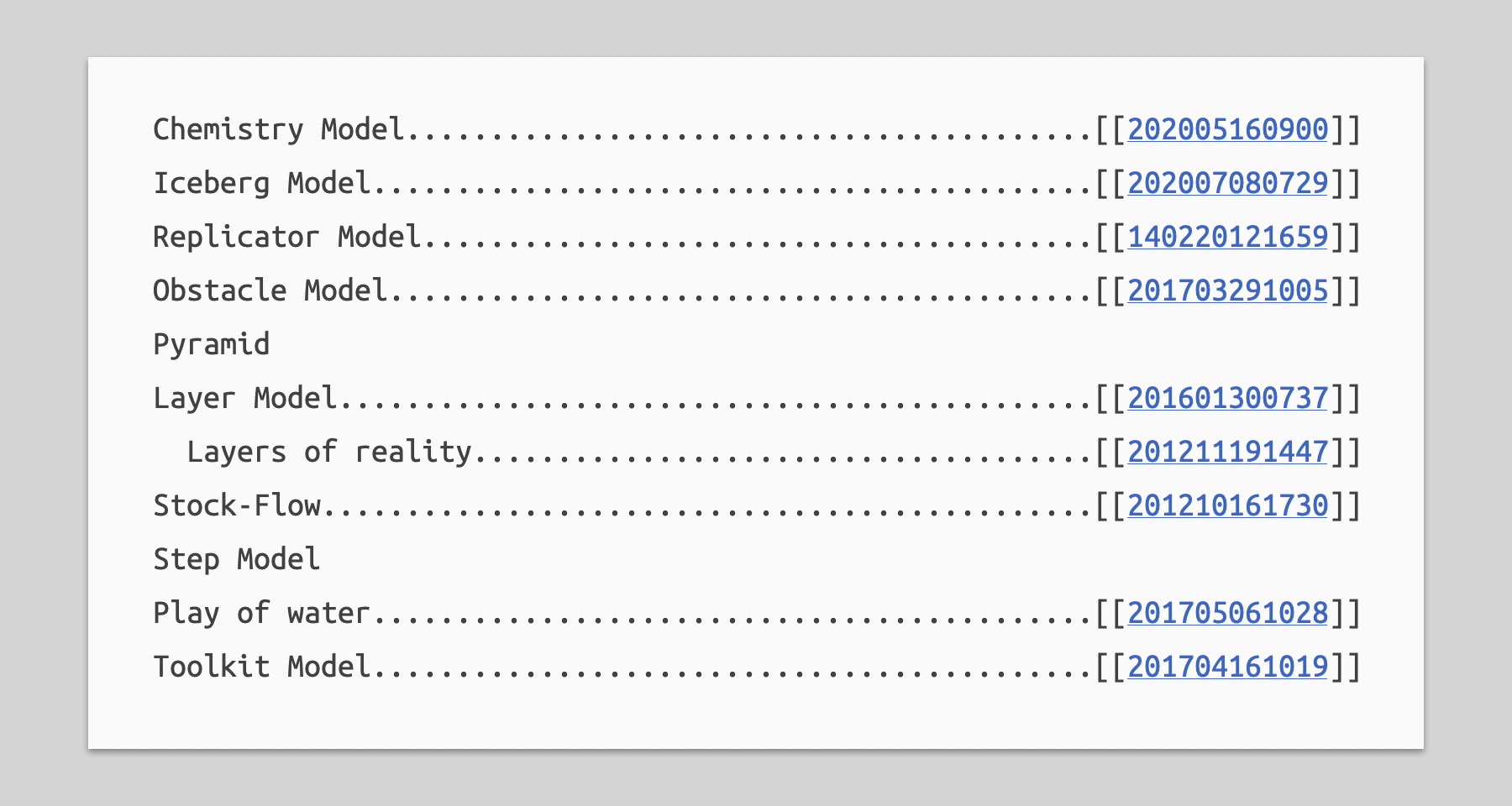
Another Structure Note of mine is about general models. Each Zettel notes a separate schema about various mental models. Two examples for illustration:
-
The obstacle model. It is a general view of the need to increase energy output to transition from one state to another. One application is the phenomenon of hunger. In nature, you need to increase your energy output (hunt or gather) to move from the state of being hungry to being sated. Concentration is another use case. It could be modelled as the ability to increase and focus your mental energy output on moving from an incomplete to a complete task.
-
The chemistry model. Its gestalt is a molecule that has atoms as parts. Atoms are the parts which are assumed not to be divisible into smaller chunks. A molecule is the composition of the elements. The Zettelkasten Method is a model of this application. Another application is Ido Portal’s teaching methods of skills.
The chemistry model is both a part of the Structure Note on general models and in the Structure Note on the Zettelkasten Method itself. Those overlaps in zettels create a semilattice structure:
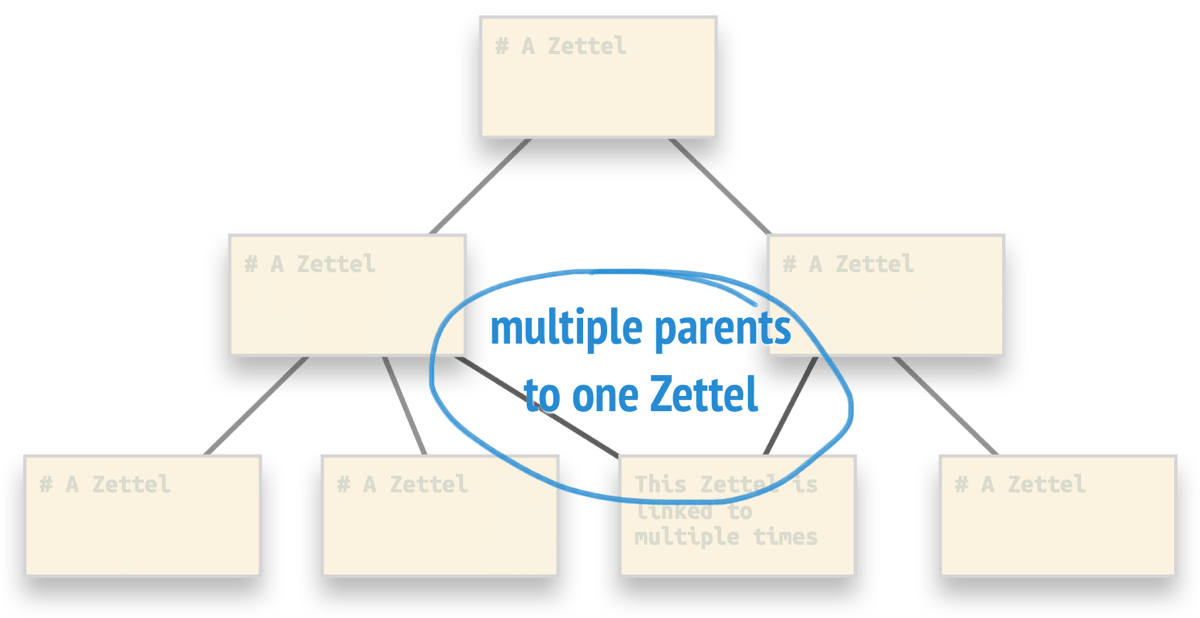
In reality, even the semilattice does not capture what is really going on in the Zettelkasten. The right model would be one of heterarchy.4 But that goes beyond the scope of this introduction.
Structure Notes are not limited to hierarchical structures like the nested list from above. Structure notes can also have sequential structures. Imagine the following line of argumentation: a -> b -> c, therefore a -> c. A Structure Note could capture this sequence and link each step of the sequence to a Zettel which expands on it. An example, with annotations to point out each step:
(
a) The stimulation of surface cold receptors is (b) the main driver of cold adaptation.[[202005201056]] Cold showers stimulate the surface cold receptors sufficiently.[[202005201057]] Therefore, (c) cold showers are a viable method of practicing cold adaptation training.[[202005201058]]
The links via [[ID]] refer to Zettels that are compilations of evidence for each statement. The structure of the arguments guides this Structure Note.
To recap: To create Zettels about the relationship between other Zettels, is called a Structure Note. The practice of creating Structure Note will further train your ability to deal with general patterns of knowledge. Capturing the results in your Zettelkasten so they will be available for later use.
How to Implement a Zettelkasten?
Choosing Software
If you choose software to handle your Zettelkasten, there are some
features the software should have. Below is an essential checklist for
features you should look for:
-
The software needs to make hypertext possible. There are two ways to accomplish this. You either use whatever linking feature the software offers – this is often more convenient for less tech-savvy people –, or you stick to the imitation of direct links through full-text search. The search-based approach is more robust over time and across apps, but perhaps a bit more awkward to get used to. See our demonstration how TextMate would handle links. Keep in mind that I didn’t modify TextMate in any way to accommodate the handling of a Zettelkasten.
-
The navigation between Zettel will depend on two things: Full-text
search and being able to follow links. The full-text search is an
equivalent of finding entry points via the register in Luhmann’s
Zettelkasten (more powerful, obviously). Links are just links as you
know them. No further explanation needed. A full-text search is an
advantageous option a digital Zettelkasten has, but an analogue
Zettelkasten doesn’t, which results in the heavier usage of it. -
A kind of sandbox. An implicit part of Luhmann’s Zettelkasten was his desk. He could just pull out any number of Zettel and arrange them on his desk as he liked. You can’t do this so easy in the digital version. In The Archive I use Structure Notes as my desktop. The arrangement is more hierarchical and not so free like physical slips of paper. But it does the job.
The Paper-Based Zettelkasten
If you chose to make your Zettelkasten paper-based, just follow the approach by Luhmann as he fleshed it out in his article “Communication with slip-boxes”.
I started my Zettelkasten journey this way and experimented with it for a couple of months. Immigration to my digital solution was quite painful. There is no automation for that unless you have very legible handwriting and can use optical character recognition (OCR) on the notes or an assistant who transcribes them for you.
The Archive
One of the main concepts of The Archive is the software-agnostic
philosophy and adherence to a simple plain text approach.
-
Software-agnosticism is the principle that you make the opposite of what boxing-in tries to achieve. There are direct ways to box you in, for example, by storing notes in a closed-off file-format that no other software can decipher. But there are also implicit ways to make it difficult to change the software, for example by making the export process difficult, or by training the user to depend on features that are not available anywhere else. One example of how we try to avoid this is our decision to make the search function responsible for carrying out a lot of the features. Even Zettel links boil down to search. Full-text search is omnipresent on computers, and therefore you can reproduce your workflow with about any plain text editor in the world.
-
The plain text approach is the paradigm of using plain text files as the primary storage. Plain text is the most versatile and durable file format.
In sum, The Archive manages a folder of plain text files. You access your files by performing a search via the Omnibar.
In The Archive, an individual Zettel should look like this:
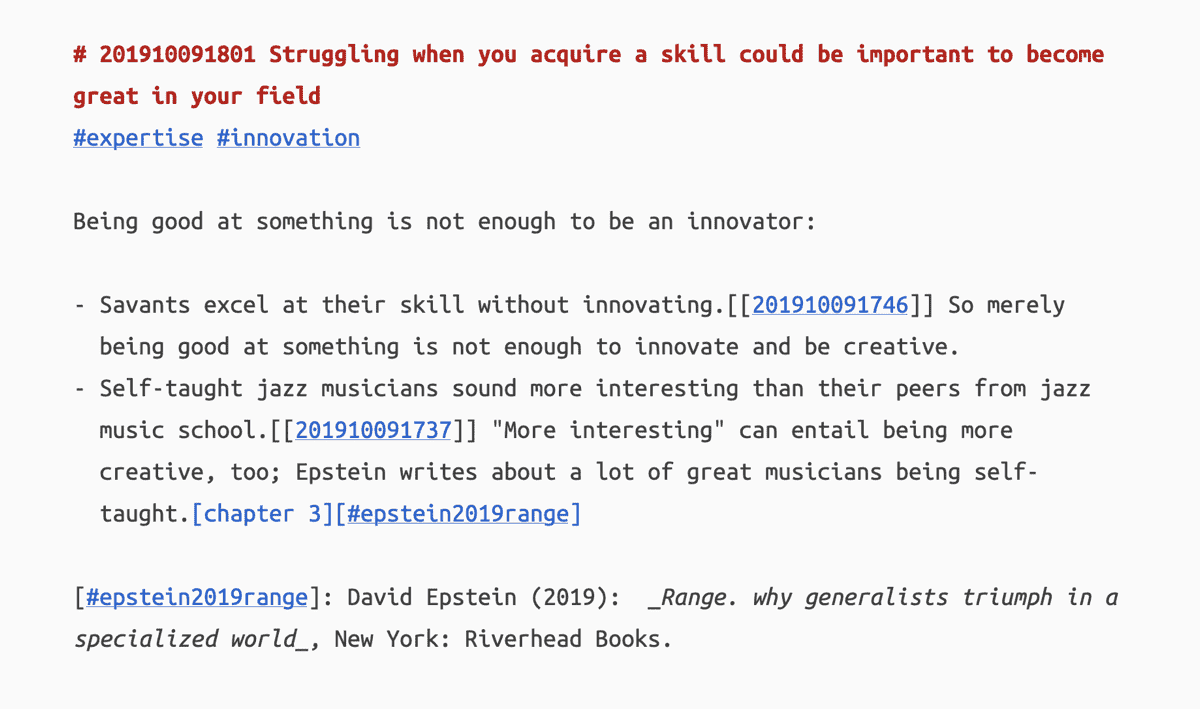
-
The ID of the Zettel is both in the filename and in the contents of the file. The main reason is to create redundancy. A use case for this practice is to access your Zettelkasten from anywhere: back in the day, I used Dropbox to access my notes from other computers. Dropbox allowed a filename-based search only. Therefore, I needed to put the ID in the title to make it possible to follow a link via the search function of Dropbox manually.
-
The ID is time-based. It never changes, so you can change the title as much as you want without breaking any links.
-
If you follow a link, you perform a search for the ID inside the double square brackets. So you can follow links with any software that can perform a search. Linking in The Archive works by putting the ID in double brackets.
-
The tags are hashtags. If you click on the highlighted hashtag, The Archive will perform a search for that tag. Tags are nothing but strings that group notes via a shared phrase that you can search for.
-
The Archive uses Markdown for marking up text. It is very readable by humans and at the same time widely adopted in tools that integrate plain text with publishing methods. Many text editors support Markdown, and you can use other tools to produce nice-looking PDF-files. Markdown comes in handy if you want to write an article or assemble a small presentation.
-
Citations and book references are added via the extended MultiMarkdown syntax. It connects beautifully with BibTeX, which is a widely-supported format to save bibliographic data in plain text files. Our recommendation for Mac is the open-source tool BibDesk and for Windows JabRef to manage the bibliographical data and connect it to the Zettelkasten via the citekeys it produces.
All the screenshots here are examples of our Zettelkastens in The Archive.
DokuWiki
DokuWiki is one of my favourite software solutions for managing a Zettelkasten. If you use DokuWiki, you could consider not making each Zettel its own wiki page. The design of the DokuWiki user interface is more tailored towards long(er) pages. This violates the principle of atomicity to appoint. However, if you link directly to subsections and each subsection contains one thought you will be fine. Every page can be divided into sections and subsections, each with its address, making it possible to treat sections as individual Zettel.
DokuWiki allows you to use title-based IDs and keeps the links functioning if you change the title names, hence the IDs. I still recommend to additionally use time-based IDs. They would just come up in the address of each site or subsection but wouldn’t be in the way otherwise. The benefit is that you will be able to export DokuWiki to another software (especially text editors) solution much easier. Think of the time-based ID part of the code of the Zettelkasten itself which can be read by various software. If the code is complete you can use a high number of apps. If you decide against some parts of the code (conventions) transitions will be much harder.
With DokuWiki, Structure Notes are regular wiki pages. They deal with structures just like plain text files do, which I described above.
Starting Now
What can you expect if you follow the Zettelkasten Method? Expect more, way more results from your efforts. Be persistent and just do it. You will likely get stuck at some point when you cannot figure out how to implement feature X or Y with your tool of choice and get things to work. This will all eventually sort itself out when you went through the motions time and again, and when you remind yourself of the basic principles of a Zettelkasten: you need identifiers as addresses, you need links to create a hypertext, and then get confident through practice. Moving forward is the only way to become something in life. So, get to work. It needs to be done. Having a Zettelkasten makes nothing easier, but it makes anything possible.
Start to learn the Zettelkasten Method now. Download our Demo Archive and play with it using The Archive (free 60 day trial) and other apps.
If you start your own Zettelkasten, share the steps of your journey with our great community in the forums! You can also discuss this introduction there.
Start reading about the Zettelkasten Method on the curated overview page
Special Thanks
I owe eternal gratefulness to @Will who did the first round(s) of beta-reading this article. I pity him for being the first exposed to my English.
Many thanks go out to the other beta readers, too, namely:
- @MikeBraddock
- @mediapathic
- @ethomasv
- @henrikenggaard
- @achamess
- @Argonsorts
Discuss the introduction on the forums
-
See https://pub.uni-bielefeld.de/download/2942475/2942530/jschmidt_2016_niklas%20luhmanns%20card%20index.pdf. ↩
-
However, Luhmann’s productivity wasn’t so high just because he used a Zettelkasten. He worked all day, every day. Being a workaholic helps in getting work done. ↩
-
Luhmann’s actual numbering system included one slash, but for didactic reasons, we chose to leave it out. He used it for better readability. ↩
-
Thanks @henrikenggaard for pointing me to this term. ↩
